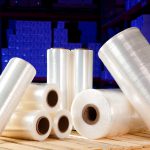
Stretch film plays an important role in delivering and transporting most of the products we use around the world. Is commonly used to wrap products on pallets and secure them to each other and the pallet. It helps to reduce product loss, injuries and discourage load tampering.
When to use Stretch Film?
You usually use stretch film when you want to hold boxes and products together on a pallet. Once the boxes and products are together you can transport or store them.
Materials
The most common stretch wrap material is Linear low-density polyethylene (LLDPE). Many of the stretch films are only stretched to about 100-300% in use. Once stretched, it is used to keep the load tight.
But they also come in a variety of speciality films, such as:
- UV stretch film
- Vented Pallet Wrap
- Anti-static stretch film
- Coloured Stretch film
Nano Stretch Film
It is an innovative product created by Thong Guan. The Nano Stretch film has 33 layers and the thickness of the layers is measured in nanometers.
Nano Stretch Film is so lightweight but at the same time strong that it can help you save up to 50% of the packaging material. Thus using Nano Stretch Film also helps save the environment and make your business more efficient.
Methods of Producing Stretch Wrap
Blown
Slower process but it gives higher quality, the cost of production is also higher, due to the quantity produced per hour.
Cost
The process is quick but the quality is not as good as blown. The costs are lower because more can be produced per hour.
Benefits of Stretch Wrap
- Loads are more secure
- Minimize shipping damage
- When the products are stored outdoors UVI stretch film can protect them from UV Rays
- Opaque Film reduces theft and protects colour products
- Stretch Film maintains products clean: free of dust and moisture.
- The packaging is more efficient, increasing worker productivity
- Improved inventory control
- Stretch film is recyclable and versatile
- When you use stretch wrap your cost decrease because it’s less expensive than strapping and other types of pallet wrapping.
- Stretch film is adaptable and there is an ample variety.
- Stretch wrap can be used on any surface, it doesn’t matter if it’s flat or pointed.
Categories and subcategories of stretch wrappers
Manual (or Hand) Wrappers:
- Extended core: This type of wrapper have very little stretch control, and is hard to handle.
- Mechanical brake: This simple structure has a mechanical brake system and uses a film roll.
- Pole wrappers: The Pole Wrappers has an ergonomic design that helps to wrap the bottoms and tops of loads.
Semi-Automatic Wrappers:
- Turntable wrappers: The load spins to wrap the load with the film roll.
- Orbital wrappers: The film is in a vertical ring, rotating to apply the film horizontally to the load.
- Rotary arm wrappers: In The Rotary Arm Wrappers the load doesn’t move while the arms turn around wrapping the load.
Automatic Wrappers:
Automatic wrappers are generally a variant of a semi-automatic system. They include:
- Conveyor System, this automatically loads the wrapping machine
- Systems to apply, seal and cut the film.
The most common ones are:
- Turntable wrappers: The load spins to wrap the load with the film roll.
- Rotary arm wrappers: In The Rotary Arm Wrappers the load doesn’t move while the arms turn around wrapping the load. Usually, it is used for small loads because of the high speed.
- Rotary ring wrappers: The rotary ring wrapper is a more balanced system. It can reach up to 160 pallets per hour. It moves up and down while the load stay static.
There are a lot of manufacturers in Malaysia and around the world so you can compare prices and choose the right one for your business and your products.
As you can see stretch film has many benefits and is the best way to transport and store products as it saves time and money. So make your business more productive and efficient and start using it.





